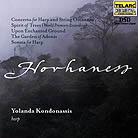June 2000
This disc, recorded in Direct Stream Digital to Telarc’s usually high standard, will disappoint no one and will certainly be a boon to the Hovhaness collector. Lovers of the harp will appreciate this disc too. Yolanda Kondonassis, an Oklahoman by birth, began her study of the harp at age nine. Now well into a career that combines teaching and frequent solo and orchestral performances, she is both sensitive and virtuosic. Every piece on this disc is a gem. With Kondonassis’ talent and the outstanding musicians who support her, the performance qualities of this disc are exceptional, too. Hovhaness is most famous for his symphony "And God Created Great Whales." With the addition of whale sounds, this symphony helped awaken many to the natural environment and the threat posed to earth’s largest mammals. But Hovhaness has any number of works that celebrate nature. This disc’s headliner is "Spirit of Trees," sonata for harp and guitar, opus 374. Kondonassis has given this piece its premiere recording. And there are two other pieces which bear nature names. The remaining two pieces do not bear nature titles, but, like the others, evoke images and feelings around natural settings. If you enjoy programmatic music, you will love this disc. Even casual listeners see brooks and trees and rainforest canopies. In the title piece, "Spirit of Trees," the guitar and harp are a perfectly complementary duo -- Leisner’s guitar begins as continuo to Kondonassis’s upper register statement of the major theme, moves through a fugal dialogue with the harp and then develops the second theme during which the harp provides ornamentation to the arpeggiated melody. This musical symbiosis continues throughout the sonata. Concerto for Harp and String Orchestra, Op. 267 starts with plucked bass viols and then the cello introduces the minor key theme which the harp then elaborates. The somber dialog between the harp and string orchestra (the excellent I Fiamminghi led by Rudolf Werthen) leads through the second movement, andante espressivo, and the third, allegretto, to "Dawn in Paradise," marked adagio rubato. The piece concludes with an adagio of heartbreaking beauty. Despite the promise of programmatic music in the titles Hovhaness gives them, the pieces here survive quite nicely on their own. Because of the harp’s innately gentle sound, some of the disc can be music for a gentle afternoon of background while you work. On the other hand, close listening reveals a complex musical intelligence at work. Every piece merits close listening. And when you hear the tam-tam enter in "Upon Enchanted Ground" for flute, cello, giant tam-tam and harp, you know that you have entered into a magical musical world. GO BACK TO: |
 Music of Hovhaness
Music of Hovhaness![[Reviewed on CD]](../format/regcd.gif) Alan
Hovhaness is a hugely prolific composer. Born in 1911, he decided in the early 1940s to
destroy much of his earlier composition. Since then, he has created music to fill some 400
opus numbers which contain over 80 symphonies. Haydn had over 100 symphonies, but, unlike
Hovhaness, he did not decide to destroy all of his work at the age of 30 to start over.
Mind you, the story is that Haydn’s wife used some of his compositions as fishwrap,
so the 103 Haydn symphonies may have been much greater.
Alan
Hovhaness is a hugely prolific composer. Born in 1911, he decided in the early 1940s to
destroy much of his earlier composition. Since then, he has created music to fill some 400
opus numbers which contain over 80 symphonies. Haydn had over 100 symphonies, but, unlike
Hovhaness, he did not decide to destroy all of his work at the age of 30 to start over.
Mind you, the story is that Haydn’s wife used some of his compositions as fishwrap,
so the 103 Haydn symphonies may have been much greater.